
Botanical tour reveals vast collection
SAN FRANCISCO— Driving into Golden Gate Park, I was taken aback by the size of the vast public space.
Roads intertwining all through the park, my taxi driver had to carefully maneuver through the many cars and people. When we finally reached the front of the San Francisco Botanical Garden (or so I thought), I got out of the car to see a huge lawn, nicely manicured with colorful flowers and a gazebo.
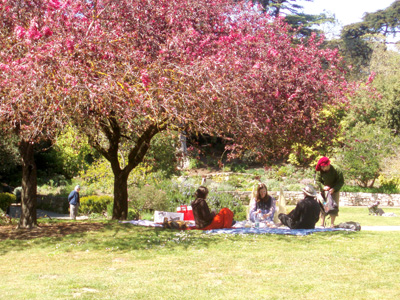 |
Visitors take a break under a crabapple tree (Photos by Gabrielle Officer). Below, Docent Carrie O’Connell points out native plants. Next, a Japanese Plum Tree in the Japanese Garden. Below, visitors at the Moon Viewing Pond in the Japanese Garden. And last, the view of the Succulent Garden, said to be the warmest spot in San Francisco. |
The scene was picture perfect, complete with couples having picnics and families strolling along the sidewalks, their kids pedaling on tricycles next to them.
I walked up the staircase to the beautifully decorated information booth to ask where my 1:30 p.m. tour was starting. The woman behind the glass informed me that I was at the Strybing Arboretum, not the Botanical Garden which was a 15-minute walk away. With all of 10 minutes until my tour was to start, I began my mile-long jog to the Botanical Garden.
I ran up to the tour group just in time, as the docent, Carrie O’Connell, was beginning her talk on the history of the Botanical Garden.
William Hammond Hall designed the entire Golden Gate Park in the late 1800s although planting at the garden did not begin until 1937. Originally it was intended to be an arboretum, housing only trees. Eventually the 55-acre garden expanded to grow more than just trees. Now it is home to more than 7,500 species of plants.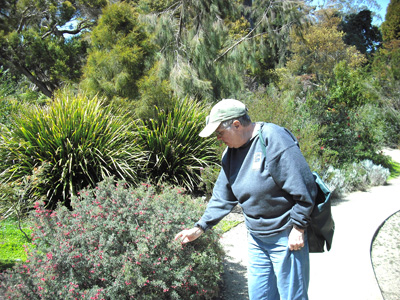
The Botanical Garden is so big that in fact, that during our two-hour tour we did not get to see the entirety of the park. Throughout the tour, we were guided through over seven different sub-gardens, all with distinct themes. The first was called the Garden of Fragrance.
Designed especially for persons with disabilities, the plants in the Garden of Fragrance come up to the eye level of anyone in a wheelchair. Perhaps more obviously featured in the garden are plants that are very fragrant. On the tour we were able to pick the leaves of plants such as lavender, both kitchen and Mexican sage, and mint.
As the tour continued we walked through open grassy areas, where all sorts of visitors happily spent their Saturday afternoon. The most unusual of the people we observed on our walk was a group of fairies. About five or six young men and women wearing wings on their backs were dancing under crabapple trees.
It looks like a scene from a Renoir,” said Carolyn Baker, a fellow tour member. Not wanting to disturb the festivities, we waved as we passed them and moved on to the Australian section of the garden.
It may seem like the San Francisco climate would be less than ideal for the vegetation native to the land down under. However both places have a Mediterranean climate, meaning dry summers and mild, but moist, winters. The only difference between San Francisco and certain areas of Australia, such as Perth, is the seasons are in reverse. In fact all the plant species grown at the Botanical Garden can be found 30 to 40 degrees North or South of the Equator.
As we walked through “Australia” we left the Evergreens of the American Northwest and entered sandy desert territory. One unusual plant there was the Grevillea, a long-stemmed plant with red flowers that curl and look like spider legs.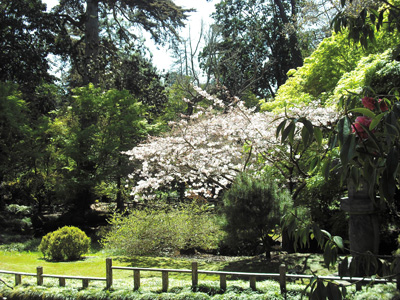
Hanging from a tree were little round green berries called Bush Cherries or Lily Pillies.
“The brave ones are welcome to taste the berries,” chuckled O’Connell.
Of course, I reached up and plucked one of the berries from a branch. Surprisingly the berry was very mild and leafy tasting.
While we made our way toward the Japanese garden, I had the opportunity to get to know some of the tour group members, namely Vicky Bowers, from Fort Morgan, Colo.
“What brings you to San Francisco?” asked my friend, Kashae Foster, a senior at the University of Miami.
“I am here for my daughter’s cancer treatments,” Bowers replied. “She would really love this. She’s studying botany at San Francisco State University.”
“What do you like most about the Botanical Garden?” I asked.
“It’s interesting to see so many different kinds of plants and flowers here. My husband is from South Africa, so I am very familiar with a lot of the South African plants that are here; it’s nice to see them again. It’s also so peaceful. I’ll definitely have to bring my daughter by,” said Bowers.
When we arrived at the Japanese Garden, we learned that mostly these gardens tend to be green with only one spot of color. The Japanese plum tree at the garden had beautiful light pink flowers that gently floated off the tree and to the ground when the wind blew. There was also a small pond with a wooden dock used to look at the moon.
“When there is a full moon we have moon-viewing parties. It’s beautiful when the moon reflects off the water. The Japanese believe that it’s a way to reconnect with family members all around the world because we’re all seeing the same moon,” said O’Connell.
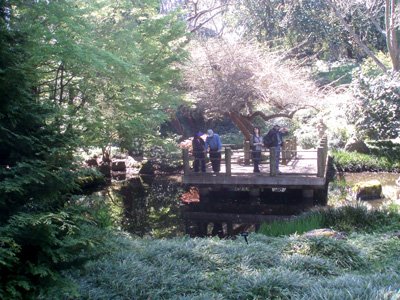 The tour concluded with a trip through the Succulent Garden, Redwood Trail and California native plants-and a few words from our docent.
The tour concluded with a trip through the Succulent Garden, Redwood Trail and California native plants-and a few words from our docent.
“What is your favorite part about volunteering here at the San Francisco Botanical Garden?” I asked.
Before O’Connell could get her answer out, an elderly couple walked up and asked her a question about a certain species of a Brazilian tree.
After helping them, she turned to us and said, “You see that is what I enjoy most. I love being able to help and educate people about such a vast and beautiful world that so often is taken for granted. When people learn about the natural world around us, they will be more likely to care about it and want to preserve it.”
If You Go:
Address:
San Francisco Botanical Garden
Located in Golden Gate Park, near the corner of Ninth Avenue and Lincoln Way.
9th Avenue at Lincoln Way
San Francisco, CA 94122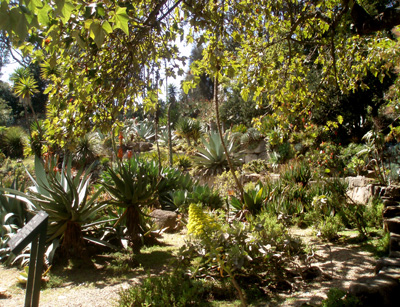
Admission: Free.
The garden is open 365 days a year.
Weekdays: 8 a.m. to 4:30 p.m.
Weekends / Holidays: 10 a.m. to 5 p.m.
Free Guided Tour
Departing from the Botanical Garden Bookstore
Mondays to Fridays: 1:30 p.m.
Weekends: 10:30 a.m. and 1:30 p.m.
Departing from the Friend Gate (north entrance)
Wednesday, Friday and Sunday: 2 p.m.
Dogs and portable stereos are not permitted at the Botanical Garden.
For full information, visit the Web site at http://www.sfbotanicalgarden.org/. Maps of the garden are available on their website under the ‘Visit’ section.

Comments are Closed